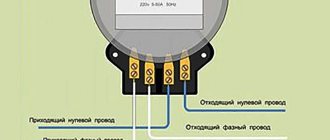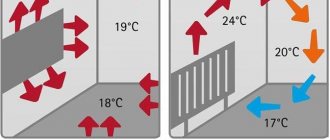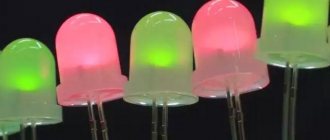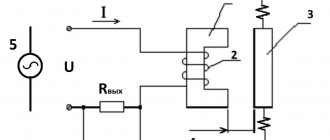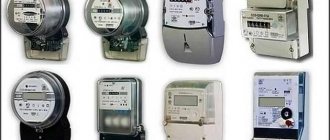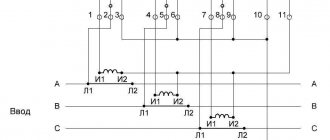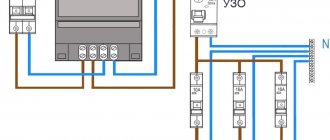SHARE ON SOCIAL NETWORKS
FacebookTwitterOkGoogle+PinterestVk
From this article you can learn the features of such a device as a two-tariff electricity meter: the main types of designs, their advantages and disadvantages, purchase prices. The text describes the procedure for installing the device and related formalities, rules for handling the meter, checking it and taking readings. The article examines in detail devices with different numbers of phases and recommendations for calculating energy consumption.
Two-tariff meters can be single- and multi-phase
Principle of operation
The two-tariff model of an electricity meter, like the classic versions, consists of current and voltage measuring circuits. The geometric sum of the data obtained from the current and voltage circuit will show the amount of power consumed by the load. But, unlike the classic single-tariff model, dual-tariff models record night and day tariff information in different data cells.
Due to the segmentation of the daily activity pattern, a person spends much more electricity in the morning and during the day. This period is characterized by several peaks and valleys, depending on the specific time. Particularly busy are the mornings, during preparation for the working day, lunch and evening hours, when most of the population returns home and gets down to routine business. And at night, the electrical system is practically unloaded.
Rice. 1. Schedule of daily load distribution in electrical networks
Such fluctuations in the power supply system have an extremely adverse effect on the equipment of power plants and substations. Since peaks of maximum load and idle speed accelerate the wear of the main elements of electrical installations. To prevent such a gap in the load on the electrical system, a program for dividing the tariff into daytime and nighttime has been adopted at the state level. The purpose of its implementation is to stimulate the population to turn on powerful electrical appliances at night in order to distribute part of the consumed electrical energy from the hours of maximum to the period of minimum consumption.
Is it advisable to switch to a two-tariff meter?
It is impossible to answer this question precisely. During periods of minimal electricity consumption, electricity suppliers reduce the tariff price by 30-60%. However, during periods when peak loads prevail, the cost per kilowatt can be increased, in some cases by up to 30%. And there is no single system for changing tariffs; it can be different for each region.
To ensure the relevance of using two-tariff equipment, many parameters should be taken into account. In particular, we are talking about the use of powerful electrical appliances and electricity tariffs in a particular city. Calculating efficiency requires a number of steps. Once the cost per kilowatt has been determined for a two-tariff and a conventional device, you should determine the amount of energy that is consumed in a particular apartment at night. And then you need to use the formula Pn=100* (Td-T1)/(Td-Tn).
Description of symbols:
- Mon - consumption of kilowatts of electricity at night;
- Td - the cost of the daily electricity tariff;
- Tn - price per kilowatt at night;
- T1 - the cost of a 24-hour tariff.
The resulting value is given as a percentage. If it turns out to be 20%, this means that for a good effect the level of electricity consumption at night will need to be increased by 20%. Only in this case is it advisable to switch to a multi-tariff system.
“New Channel” raised the question of whether it is worth installing two-tariff equipment to monitor electricity readings.
Advantages and disadvantages
During operation, a two-tariff electricity meter calculates the kilowatts consumed from 07:00 in the morning to 23:00 in the evening at the regular tariff, and in the period from 23:00 to 07:00 in the morning at a cheaper tariff. Therefore, the main benefit of such an electricity meter will make itself felt when the equipment operates at night. The main advantages of using two-tariff models include:
- Saving money – the main advantage for the population is the opportunity to save money on paying bills. Despite the fact that installing a two-tariff electricity meter requires the consumer to purchase an electrical energy meter, it will pay for itself within 1 to 2 years of active operation.
- Load redistribution - in view of the opportunity to pay less, residents, as a rule, try to turn on the most powerful equipment after 23:00. At the same time, set the maximum mode for electric heating systems, start the washing machine or bread maker. There are quite a lot of options for implementing two-tariff consumption and each person should consider the possibility of its implementation on an individual basis.
- Reducing the likelihood of power shortages during peak periods of consumption - on the scale of a village, city or specific power plant, load redistribution will avoid voltage sag and system overload. Which, in turn, will affect the quality and durability of electrical appliances.
- Reducing the number of electrical equipment overloads at transformer substations . This will reduce the frequency of emergency shutdowns, the time to restore normal operation of the system, and the de-energization of consumers during emergency response.
But, in addition to the advantages of using two-tariff electricity meters, there are also some disadvantages. Thus, real savings are possible only for those consumers who are able to ensure night operation of electrical equipment. Otherwise, a two-tariff electricity meter may not pay off.
It should also be noted that not all cities and regions can use a two-tariff system of payment for consumed electricity. Since this function is regulated at the state level, the preferential price can be canceled at any time, especially since the issue has already been raised. When using an inflated daily tariff in some regions, the result of savings can be reduced to 10 - 15%. Therefore, before installation it is necessary to calculate the feasibility of such a replacement.
Varieties
There are single-phase, three-phase, first and second class meters. There is a classification of units with additional options: the ability to save readings for past calendar months, with the ability to transfer readings directly to the supplier and with a log of peak periods. Devices are also divided according to installation method. There are rack, three-point and combined mounts.
A type of two-tariff counting equipment
Installation nuances and connection diagram
To prevent damage to the electric meter from illegal actions of third parties or aggressive environments, a protective casing or shield is provided. However, when installing an electricity meter in a protective casing or shield in accordance with clause 5.3 of GOST 31818.11-2012, it is necessary to provide a transparent window to allow readings to be taken.
Rice. 2. An example of a window for taking readings on the casing of an electric meter
An important nuance when installing a two-tariff electricity meter is the need to coordinate the replacement with the management company. The electricity consumer must first submit an appropriate application to transfer the metering point to a two-tariff mode. If such an opportunity exists and there are no debts at your address, then the contract department will issue a receipt for payment for services for the dismantling of the old electricity meter, installation and commissioning of a two-tariff electricity meter.
In accordance with clause 1.5.27 of the PUE, electricity meters must be installed inside dry heated rooms. Therefore, you can always counter the demands of the electricity supply organization to move the electricity meter outside the premises. However, please note that if the electricity meter is located in the house, you will have to provide unhindered access to the metering point for company representatives.
To connect a two-tariff electricity meter to a single-phase network, you must use the diagram shown in the figure below:
Rice. 3. Connection diagram for a single-phase two-tariff electricity meter
To do this, you need to connect phase conductor L from the supply line to terminal 1 of a two-tariff electricity meter, and connect phase conductor from terminal 2 to the load. The neutral conductor N is connected similarly to terminal 3 of a two-tariff electricity meter, and from terminal 4 to the internal distribution circuit and household electrical appliances. This is the most common option for most household consumers powered by a single-phase circuit. The connection method and marking of the terminals may differ depending on the specific model of the two-tariff electric meter, so you need to take into account the individual connection diagram.
For enterprises or a separate segment of household consumers, three-phase power supply schemes can be used. In which it is advisable to install a three-phase two-tariff electricity meter.
Rice. 4. Connection diagram for a three-phase two-tariff electricity meter
A three-phase electricity meter is connected in a similar way; each of the phase conductors L1, L2, L3 is connected in turn to the terminals of the electric meter, and from the same terminals they are connected to the load. The neutral conductor N is also connected to the electric meter and from the terminal to the load. To protect the electricity meter itself, an input circuit breaker is installed, after which circuit breakers, UDTs and other protective devices can be used.
Read more information about connecting electricity meters in the article:
Reprogramming of multi-tariff electricity meters Mercury
For those wishing to order services for programming electricity meters through our website www.77cs.ru, please be sure to first read the information below.
We inform you that this activity is not LICENSED, i.e. does not require a license from the organization or private master who can provide it. If you have the skills, specialized equipment and software, you can even independently configure the purchased electric meter, which belongs to you, after its purchase, as property. This is legal in cases where network or sales organizations require you to purchase a new electricity meter (electricity meter). After programming, you have the right to install this electric meter where necessary, then provide it to a network or sales organization for sealing and issuing a certificate of approval (putting) of the meter into operation. You may be informed by telephone about the requirements for a license or other similar documents that are not mandatory for these services by illiterate or deliberately misleading employees of a number of network and sales organizations. Such organizations, if necessary, themselves must program the electricity meters of their subscribers, but a number of them have stopped doing this, because, apparently, it is not profitable for them. We inform you that all licensed types of activities on the territory of the Russian Federation are regulated by the Federal Law “On Licensing of Certain Types of Activities” dated May 4, 2011 N 99-FZ. Anything that is not specified in this law is not subject to licensing. The need for a license to program and configure electricity meters (electricity meters) is not mentioned in this law. This confirms the groundlessness of the license requirements for electricity meter programming services.
How to take readings?
To take readings, you need to know the day and night tariff designation for the installed electricity meter model. Typically, these parameters are designated as follows:
- T1 or T – general data;
Rice. 5. General data of a two-tariff electricity meter
- T11 or T1 – daily tariff readings;
Rice. 6. Daily tariff of a two-tariff electricity meter
- T12 or T2 – night tariff readings.
Rice.
7. Night tariff of a two-tariff electricity meter In some models of two-tariff electricity meters, this data changes automatically at specified intervals. In others, they change by pressing the corresponding button.
To pay the bill for consumed electricity, you will need to write down the numbers to the left to the decimal point. First, the receipt for payment indicates the daytime rate, then the night rate. If you have an electronic account, data can be entered through an online form.
Who benefits from these electricity meters?
The use of a two-tariff electricity meter will not be beneficial for everyone, so before purchasing such an electricity meter, you need to consider the following criteria:
- Does the energy supply company in your region offer the option of calculating daytime and nighttime tariffs? If not, then a two-tariff electricity meter will not help save money.
- Powerful electrical equipment is actively used in your home or apartment - stoves and ovens for cooking, washing machines, microwaves, etc. If you use gas appliances, and the only electrical consumers you have are a refrigerator, TV and LED lamps, you will not see any savings.
- For heating, an electric heated floor or an electric boiler or boiler is used. Then installing a two-tariff electricity meter with tariff division is more than justified.
- You can organize the operation of powerful electrical equipment from 23:00 to 07:00. If the whole family goes to bed early and you don't have a portable timer, then a two-tariff electricity meter will be useless.
Owner's procedure
Installing a new meter requires certain steps. They are not much different if the meter has expired or has broken down and needs to be replaced with a new one.
There is a certain procedure that the owner must follow when installing the meter.
To do this he must:
- Contact the energy sales office with an application, which will be reviewed within 7 days;
- To do this, you will need the owner’s passport or a power of attorney if the application is submitted by another person;
- The inspector will require proof of ownership. It is necessary to provide a purchase and sale agreement, deed of gift, etc.;
- Permit, technical specifications and project for installation of electrical equipment. Ground loop test report. It is provided with a three-phase connection;
- A date is agreed upon for the inspector to visit to check the correct installation of electrical equipment. The inspector must arrive no later than 15 days from the date of filing the application;
- Electrical equipment is being installed. It can be installed on its own, if the owner has the appropriate skills, or by an invited electrician;
- An act is drawn up in two copies; if installation and commissioning is carried out by a third-party organization, the number of acts will be three. It indicates the owner’s data, meter type, primary readings, seal number.
The acts are signed by all interested parties and take their copies. The owner must keep his copy. It is presented to the inspector during inspection.
